Welcome to the definitive bathroom remodeling guide! You’ve come to the right place if you’re thinking about remodeling your bathroom. We’ll go over everything you need to know about organizing, budgeting, and carrying out a successful bathroom remodel in this extensive guide. This guide can help you whether your goal is to make a few small updates or a substantial renovation.
This in-depth manual on bathroom remodeling has been provided to you by New York Bathroom Remodel, a business committed to assisting New York City homeowners in designing the bathroom of their dreams. To assist you in organizing and carrying out a successful bathroom remodel, we have covered a wide range of topics, from choosing materials and fixtures to maximizing storage and improving lighting.
If you need advice or assistance when planning a bathroom remodel in New York City, we can help. From planning and design to construction and completion, our team of skilled builders and designers can assist you at every stage. We have the knowledge and tools to support you in achieving your objectives, whether you’re looking to renovate a small bathroom or build a luxurious spa retreat. To find out more about how we can assist with your bathroom remodeling project in New York City, get in touch with us right away.
Section 1: Planning Your Bathroom Remodel
1.1 State Your Objectives
Setting goals is crucial before starting any remodeling project. What are your objectives for remodeling the bathroom? Do you want to make your home more valuable, make it more useful, or simply update the bathroom’s appearance and atmosphere? Your decisions throughout the process will be aided by having a clear understanding of your objectives.
1.2 Establish a Budget
Budget is an essential component of any remodeling project, so you must set one up for your bathroom renovation before you get started. Be sure to take into account any additional costs, such as those for permits or design fees, in addition to the price of materials and labor. Additionally, it’s a good idea to set aside money for unforeseen expenses that might occur during the renovation process.
1.3 Select a design aesthetic
Selecting a design style is one of the most enjoyable aspects of planning a bathroom renovation. Do you gravitate toward more contemporary, minimalist designs or a more traditional appearance? Consider your home’s overall design before selecting a style, and vice versa.
1.4 Make a floor plan
It’s time to create a floor plan once your objectives, spending limit, and design aesthetic have been decided. This will make it easier for you to picture the design of your new bathroom and guarantee that everything fits and works properly. Think about things like your fixtures’ locations, electrical outlets, and plumbing.
Section 2: Material and Finish Selection
2.1 Surfaces
There are a number of flooring options available for bathrooms. Natural stone, vinyl, and ceramic tile are common options. When choosing your flooring material, take durability, upkeep, and cost into account.
2.2 Worksurfaces
The material you choose for your bathroom countertops matters because they will be put through a lot of wear and tear. Quartz, marble, and granite are common choices. Your countertop’s color, pattern, and maintenance requirements should all be taken into acount.
2.3 Vanities and Cabinets
Vanities and cabinets have a big impact on how your bathroom looks and feels. Consider factors like storage needs and the size of your space as you choose a style that goes well with your interior design aesthetic.
2.4 Lighting
Sinks, faucets, and showerheads are examples of fixtures that are not only useful but also enhance the aesthetic appeal of your bathroom. Consider factors like durability and upkeep when choosing fixtures that go with your design aesthetic.
2.5 Hardware and extras
When planning your bathroom remodel, don’t forget to take the little things into account. Towel bars, soap dispensers, and shower curtains are examples of hardware that can significantly alter the appearance and atmosphere of your bathroom.
Section 3: Contracting Out
3.1 Locating Contractors
The choice of a qualified, experienced contractor is crucial when remodeling a bathroom. Ask friends and family for recommendations or start by browsing online directories and review sites.
3.2 Questioning the Contractors
Start the interview process as soon as you have a list of potential contractors. Inquiries to make during the interview include the following:
How long has your company been around?
Can you provide testimonials from previous customers?
Do you have a license and insurance?
Do you have a particular area of remodeling expertise?
How do you handle unforeseen expenses or project changes?
Can you offer a thorough budget and schedule for the project?
3.3 Picking a Contractor
It’s time to select the ideal contractor for you after speaking with a number of them in interviews. Think about things like their level of experience, the caliber of their work, and the way they communicate. Don’t be afraid to haggle over price, but remember that the lowest offer may not always be the best option.
Section 4: Carrying out the Renovation
4.1 Getting Ready for the Renovation
There are several steps you must take in order to get ready before the remodeling work actually starts. This might entail packing up temporary items like towels and toiletries and, if the renovation is extensive, moving into a temporary home.
4.2 Construction and Demolition
You can anticipate a certain amount of disruption to your daily schedule during the remodeling’s demolition and construction phases. Although your contractor will make every effort to limit this inconvenience, it’s important to be ready for some noise and mess.
4.3 Final Details
It’s time to give your new bathroom the finishing touches after construction is finished. This might entail painting, setting up hardware and fixtures, and adding extras like towels and decorations.
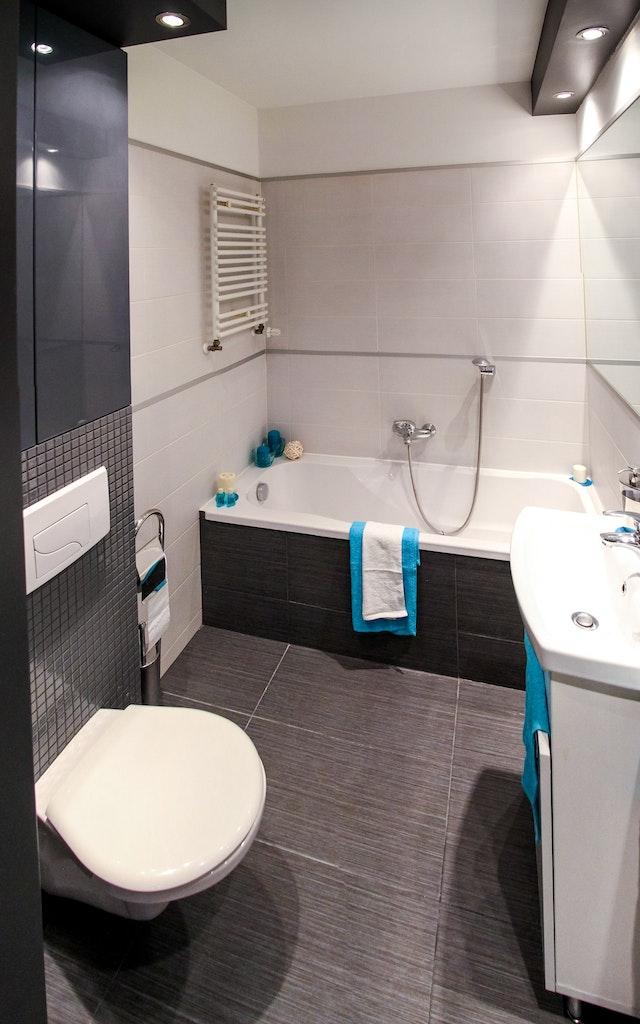
Section 5: Upkeep and Maintenance
5.1 Maintaining a Clean Bathroom
Maintaining cleanliness after your bathroom renovation is finished will help it look its best. Your fixtures and finishes will last longer with regular cleaning and maintenance because it will help prevent damage. Here are some pointers for maintaining a spotless bathroom:
Regularly clean surfaces with a mild cleaner.
To dry off the shower doors and walls, use a towel or a squeegee.
Utilize a disinfectant cleaner to regularly maintain the toilet.
Regularly empty the trash to avoid odors.
Use a shower curtain or a shower liner to prevent water damage to your walls.
5.2 Modernizing and Redesigning
After some time, even the most beautifully renovated bathroom may begin to feel stale. Consider updating or renovating your bathroom if you want to give it a new look. This can be as straightforward as replacing your towels and other accessories or as involved as updating your countertops or replacing your shower head.
5.3 Dealing with Problems and Repairs
Unfortunately, problems can arise or repairs may be required even in the best-planned and executed bathroom remodel. If there are any issues with your bathroom, you should take care of them right away to stop further harm. This might entail taking care of emerging problems, such as replacing cracked tiles or repairing leaks.
Section 6: Typical Errors to Avoid
6.1 Compromise of Quality
One of the biggest errors that homeowners make when remodeling their bathrooms is sacrificing quality in order to save money. While it may be tempting to select the least expensive option, this frequently results in issues later on. You might need to replace cheap materials sooner than you’d like to because they might not hold up as well. It is preferable to spend more money on better materials that will last longer and cost you less in the long run.
6.2 Not Making Future Plans
Not making future plans is a typical mistake. If you intend to live in your house for a long time, it’s crucial to think about how your bathroom will be used over time. In the future, will you need to make room for a wheelchair or another type of mobility aid? Will you require more space for storage or a bigger shower? You can save time and money in the long run by making preparations for these things now.
6.3 Forgetting to Apply for Permits
You might need to obtain building permits, depending on the size of your bathroom remodel. Failure to obtain the required permits could result in future delays and issues. Always check with your neighborhood building department to find out what permits you require and how to apply for them.
6.4 Failing to contact your contractor
For a bathroom remodel to be successful, communication with your contractor must be effective. Maintain open lines of communication with your contractor throughout the process and be sure to discuss your objectives, financial constraints, and schedule with them. This will make it more likely that your project will proceed as planned and meet your expectations.
Section 7: Bathroom renovations in New York City
7.1 Locating a Contractor in New York
You must hire a licensed, experienced contractor if you’re planning a bathroom remodel in New York City. Since there are many contractors in the city, it’s crucial to do your homework and pick one with a solid reputation and a proven track record of success. If you’re looking for contractors in your area, think about asking your friends and family for recommendations. You can also search online directories and review sites.
7.2 Setting a Budget for a Bathroom Renovation in New York City
When remodeling a bathroom, cost is always a major factor to take into account, and in an expensive city like New York, this is especially true. Establishing and adhering to a budget is crucial because the cost of labor and materials in the city can be higher than in other regions of the nation. Remember that additional costs like permits and design fees might also need to be planned for.
7.3 Getting a Permit in New York City: A Guide
You might require city building permits, depending on the size of your bathroom remodel. Working with a contractor who is familiar with the process and can help you navigate it is essential because the permit process in New York City can be complicated. To find out what permits you require and how to get them, be sure to contact your neighborhood building department.
7.4 Choosing Bathroom Finishes and Materials in New York City
It’s crucial to pick materials and finishes for your bathroom in New York City that are long-lasting and resilient to the busy, fast-paced lifestyle of the city. For your countertops, take into account materials like quartz, quartzite, and natural stone, and select long-lasting fixtures.
It can be difficult but rewarding to remodel a bathroom in New York City. In the middle of the city, you can design the bathroom of your dreams by working with a skilled contractor, creating a budget, dealing with the permit procedure, and selecting long-lasting materials and finishes. Your bathroom remodel in New York City can be successful with careful planning and attention to detail.
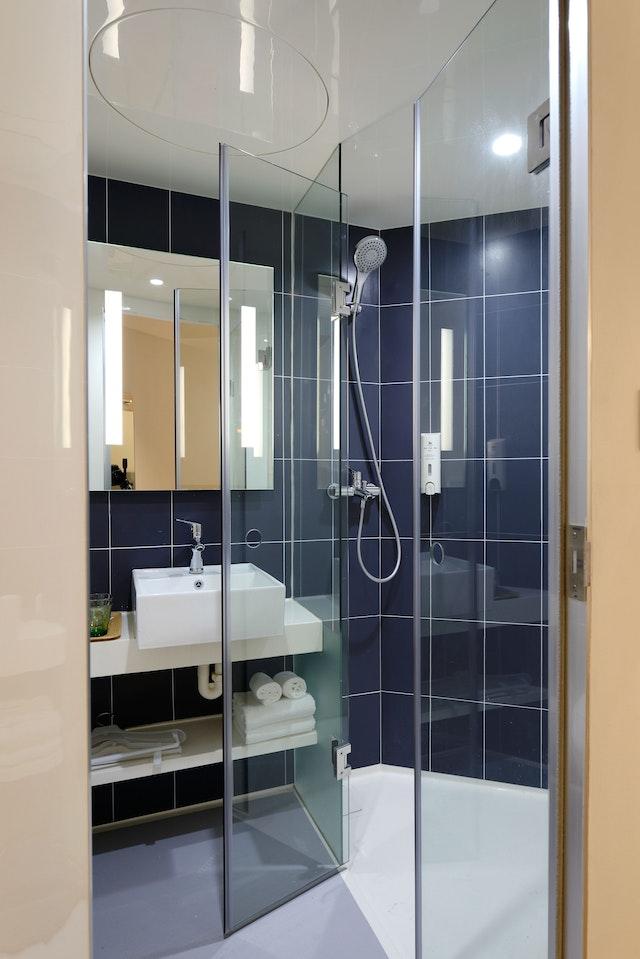
Section 8: Typical Questions Regarding Bathroom Renovations
8.1 How long does it take to remodel a bathroom?
Depending on the size of the project, a bathroom remodel may take a certain amount of time. While a bigger, more complex renovation might take a few weeks or even months, a smaller, simpler remodel might only take a few days. It’s crucial to go over the timeline with your contractor and make appropriate plans.
8.2 How much does remodeling a bathroom cost?
The scope of the project will determine how much it will cost to remodel a bathroom. A smaller, more straightforward renovation might cost a few thousand dollars, whereas a bigger, more involved one might cost tens of thousands. It’s crucial to set a budget and collaborate with your contractor to find affordable solutions that satisfy your needs.
8.3 Can I remodel my bathroom myself?
While it is possible to complete some aspects of a bathroom remodel on your own, hiring a qualified contractor is usually advised. A qualified contractor can guide you through the permit process and other technicalities and has the knowledge and experience to ensure that the work is completed safely and correctly.
What factors should I take into account when remodeling a small bathroom?
When remodeling a small bathroom, it’s crucial to maximize the available space. To give the impression that the space is larger, think about installing a floating vanity, using compact fixtures, and choosing light colors. The use of mirrors to reflect light and maximizing storage can both make a small bathroom appear larger.
Section 9: Alternative Bathroom Remodeling Options
9.1 Facelift
Consider refacing your cabinets and vanities if you want to give your bathroom a new look without undertaking a major renovation. Instead of replacing your current cabinets entirely, this process involves modernizing their doors, drawers, and hardware. Refacing can be a less expensive and time-consuming option than a complete remodel to update the appearance of your bathroom.
9.2 Recaulking
Recaulking is a quick and affordable way to update your bathroom if you’ve noticed that it’s beginning to look a little worn out or out of date. Caulk can become damaged, discolored, or cracked over time; replacing it can help give your bathroom a crisp, clean appearance. This procedure is comparatively quick and simple, and it can significantly alter the way your bathroom looks as a whole.
9.3 Updating Equipment
A quick and simple way to give your bathroom a new look is to update your fixtures. Your bathroom can be made more functional and stylish by replacing your faucets, showerhead, and other fixtures. Consider your design preferences and your financial situation when choosing new fixtures, and make sure to go with options that will last and require little upkeep.
Section 10: Including Eco-Friendly Elements in Your Bathroom Renovation
10.1 Low-Flow Appliances
Installing low-flow fixtures in your bathroom is one way to make it more environmentally friendly. Low-flow faucets and showerheads use less water than conventional fixtures, which can help you use less water overall and pay less in utility costs. Look for fixtures that have been independently tested and verified to meet strict efficiency standards, such as those that are WaterSense certified.
10.2 Power-saving lighting
Another way to improve the sustainability of your bathroom is with energy-efficient lighting. Consider using LED bulbs, which consume less energy and have a longer lifespan than conventional incandescent ones. To further reduce your energy consumption, think about installing dimmer switches. Also, remember to turn off the lights when you leave a room.
10.3 Eco-Friendly Materials
Consider sustainable and environmentally friendly options when choosing materials for your bathroom remodel. This could involve using natural, non-toxic products, recycled materials, or reclaimed wood. Instead of vinyl flooring, think about using natural stone or ceramic tile, and look for countertop materials that are made from recycled materials or are approved by a sustainable forestry program.
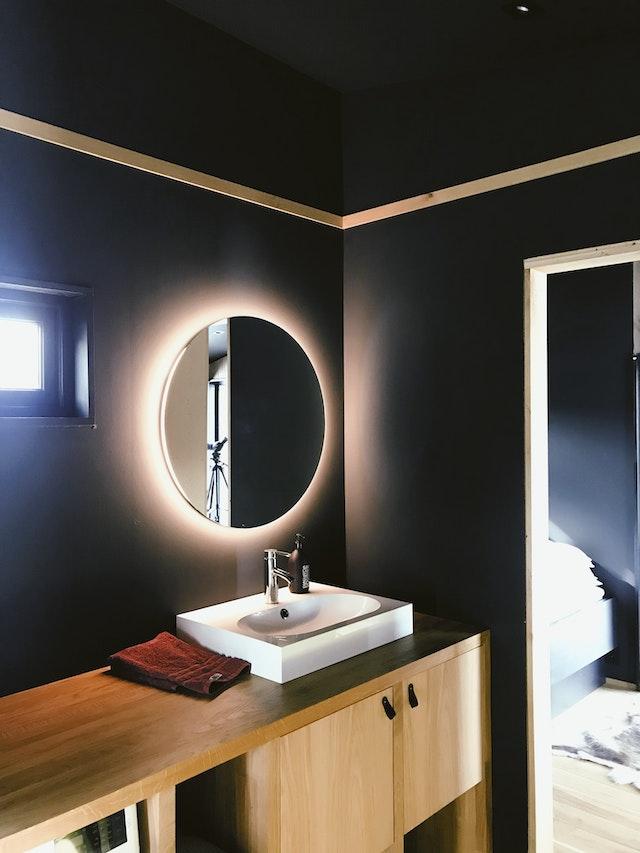
Section 11: Bathroom Remodeling Considerations for Accessibility
11.1 Creating a Safe and Accessible Bathroom
When planning your bathroom remodel, keep in mind any accessibility requirements you or a member of your family may have. The following straightforward improvements can significantly improve the security and usability of your bathroom:
installing handrails and grab bars
changing to a roll-in or walk-in shower or bathtub
adding a shower seat or a handheld showerhead
installing a toilet with a comfort height
Adding lever handles or touchless controls to your faucets
11.2 Making Future Plans
It’s a good idea to think about how your bathroom might need to change in the future to meet any potential mobility or accessibility needs if you intend to stay in your home for a long time. This might entail including a roll-in shower in the bathroom design, including a floor drain, or adding a lift system. You can make sure that your bathroom will always be a useful and secure space for you and your family by making future plans.
Section 12: Advice for New York City Bathroom Renovation
12.1 Selecting a Contractor
Working with a qualified, experienced contractor is crucial when remodeling a bathroom in New York City. In the city, look for a contractor with a solid reputation and a proven track record of success. To find contractors in your area, think about asking friends and family for recommendations or searching online directories and review sites.
12.2 Planning Your Remodel’s Budget
Budget is always a major factor in bathroom remodeling, and it’s crucial in a city like New York where housing costs are so high. It’s critical to create and adhere to a budget because labor and material costs in the city may be higher than in other regions of the nation. Remember that you might also need to set aside money for extra costs like licenses and design fees.
12.3 Using the Permit System
You might need to apply for building permits from the city, depending on the size of your bathroom remodel. Working with a contractor who is knowledgeable about the procedure and who can assist you through it is essential because the permit process in New York City can be complicated. Always check with your neighborhood building department to find out what permits you require and how to apply for them.
12.4 Materials and Finishes to Consider
It’s critical to select materials and finishes for your New York City bathroom that are strong and resilient enough to withstand the busy, fast-paced lifestyle of the city. For your countertops, take into account materials like ceramic tile, natural stone, and quartz, and go with long-lasting fixtures.
Section 13 Maximizing Storage in Your Bathroom
13.1 Making Use of Wall Space
Utilizing the wall space in your bathroom is one way to increase storage. For the purpose of storing towels, toiletries, and other items, think about installing shelves or wall-mounted cabinets. To keep things arranged and accessible, you might also think about using baskets or bins.
13.2 Constructing a Linen Cabinet or Closet
You might want to think about installing a linen closet or cabinet if your bathroom doesn’t already have one. This can help you organize towels, washcloths, and other linens while also making room in your bathroom’s cabinets and drawers for other items.
13. 3 Utilizing above-the-toilet storage
Adding over-the-toilet storage to your bathroom can be a great way to increase its storage space. Shelving units, cabinets, and ladder-style organizers are just a few of the choices. Pick a design that satisfies your storage needs while complementing the decor of your bathroom.
Section 14: The Value of Proper Ventilation in Your Bathroom
14.1 Lowering Humidity and Moisture
For a bathroom to effectively reduce moisture and humidity levels, environment by making sure your bathroom has adequate ventilation.
14.2 Improving the Air Quality Indoors
The quality of the air inside your bathroom can also be improved with proper ventilation. Mold and other pollutants can grow easily in conditions where moisture is allowed to accumulate. You can help remove extra moisture and enhance the quality of the air in your entire home by ventilating your bathroom.
14.3 Selecting an Effective Ventilation System
When it comes to ventilation systems for your bathroom, you have a variety of options. Exhaust fans, window vents, and in-wall fans are a few typical options. The best option for your bathroom will vary depending on the room’s dimensions, your spending limit, and your ventilation requirements.
Section 15: Tips for Choosing the Right Bathroom Fixtures,
15.1 Think about your design aesthetic
It’s crucial to take your design preferences into account when choosing fixtures for your bathroom. Do you gravitate toward more contemporary, sleek designs or a more classic appearance? Select fixtures that go with the style of your bathroom as a whole and enhance the furnishings you already have.
15.2 Keep Functionality in Mind
The functionality of your bathroom fixtures should also be taken into account in addition to their aesthetic appeal. Consider your daily activities and bathroom usage. Would you prefer a fixed showerhead over a handheld one? Would a single sink work just as well as a double sink? Choose fixtures that will meet your needs and improve the effectiveness and enjoyment of your daily activities.
15.3 Think About Your Budget
Another important factor to keep in mind when selecting bathroom fixtures is your budget. Establish your spending limit before looking for fixtures, then stick to it. Remember that investing in higher-quality fixtures is typically a smart move because they will last longer and possibly cost less in the long run.
15.4 Consider Robustness and Simple Maintenance
Make sure to choose fixtures for the bathroom that are long-lasting and simple to maintain. Look for lighting fixtures that are long-lasting and have a solid warranty. To help ensure the longevity of your fixtures, think about selecting finishes that are resistant to tarnishing and corrosion. You should also make sure to follow the manufacturer’s cleaning and maintenance instructions.
Section 16: Incorporating Luxurious Elements Into Your Bathroom Renovation
16.1 Spend money on high-quality furnishings.
Investing in high-end fixtures is one way to give your bathroom remodel a touch of luxury. This might include a touchless faucet, a freestanding tub, or a rain showerhead. These fixtures can give your bathroom a more upscale feel while also enhancing its usability.
16.2 Keep in mind Heated Floors
If you live in an area with cold winters, heated floors may be a luxurious addition to your bathroom. In addition to giving you a warm, comfortable place to stand, heated floors can help you use less energy by enabling you to lower your thermostat.
16.3 Add a bidet
Your bathroom may benefit from and be made more opulent by the addition of a bidet. In addition to being more hygienic and thorough, a bidet can be more environmentally friendly than using only toilet paper. For an extra touch of luxury and improved functionality, think about including a bidet in your bathroom renovation.
16.4 Construct a steam room
A luxurious and soothing addition to your bathroom could be a steam shower. Steam showers can provide a spa-like experience in the comfort of your own home while also easing sore muscles and boosting circulation. For an additional touch of luxury, think about including a steam shower in your bathroom remodel.
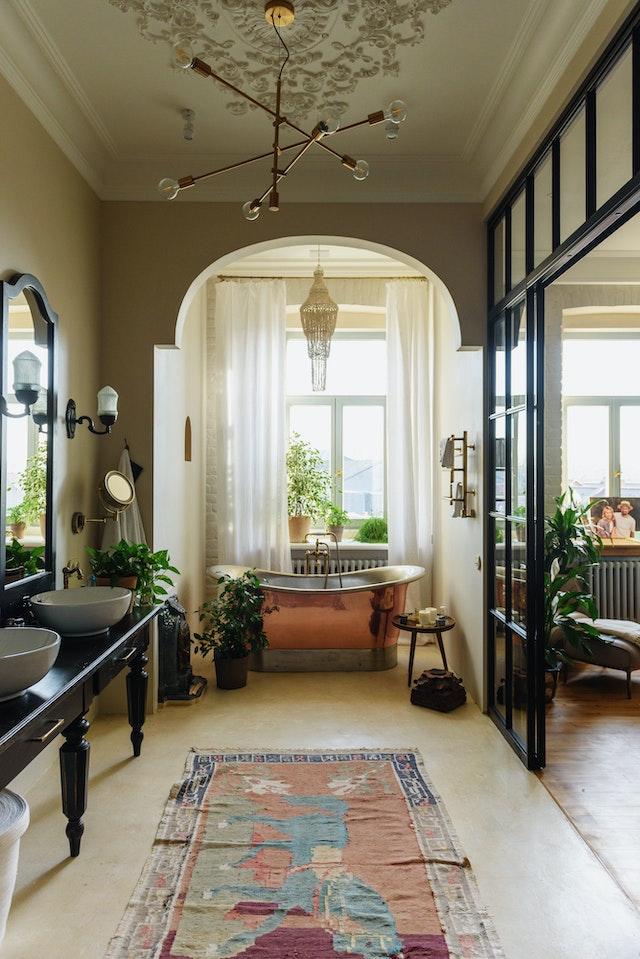
Section 17: Improving Your Bathroom’s Lighting
17.1 Deciding on the Proper Lighting Fixtures
In a bathroom, good lighting is crucial, and picking the right light fixtures can significantly alter the room’s appearance and atmosphere. When choosing fixtures for your bathroom, take into account the room’s dimensions and design. To create a well-balanced, useful lighting scheme, you might want to think about mixing ambient, task, and accent lighting.
17.2 Making Use of Natural Light
If your bathroom has windows, think about how you can make the most of the light there. To add more light, you might want to install a skylight or a bigger window. You could also use sheer drapes or blinds to filter the light while preserving your privacy. Your bathroom can feel airy and welcoming thanks to natural light.
17.3 Adding Dimmer Switches
A useful addition to your bathroom lighting plan can be dimmer switches. When you’re winding down at the end of the day, they can help you relax by allowing you to change the brightness of your lights according to your needs. To give you more control and flexibility over your bathroom lighting, think about installing dimmer switches.
17.4 Update Your Light Bulbs
Another quick way to improve bathroom lighting is to change your lightbulbs. Use LED bulbs, which consume less energy and have a longer lifespan than conventional incandescent ones. Additionally, LED bulbs come in a variety of colors and designs, allowing you to match them to the design of your bathroom.
Section 18: Remodeling Tips for Small Bathrooms
18. 1Making the Most of Storage
Making the most of your available storage is crucial if you have a small bathroom. To help free up space in your cabinets and drawers, look for ways to utilize wall space, such as by adding shelves or cabinets, and think about using over-the-toilet storage.
18.2 Selecting Small Fixtures
It’s critical to pick fixtures for a small bathroom that are space-efficient and compact. To help save floor space, think about installing a wall-mounted toilet, a pedestal sink, or a corner sink. To save space, you might also want to think about a walk-in shower or a shower/tub combination.
18.3 Using light colors
Small bathrooms can feel larger and more open by using light colors. To help reflect light and create a brighter atmosphere, think about painting your walls a light color like white, cream, or pale blue. You should also choose light-colored fixtures and finishes.
18.4 Mirror Added
In a small bathroom, a mirror can help give the impression of more space. To help reflect light and give the impression of a larger space, think about installing a large mirror or a series of smaller mirrors.
Making the most of the space you have is crucial if your bathroom is small. You can design a small bathroom that is both practical and fashionable by making the most of the storage space, picking small fixtures, using light colors, and including a mirror. Even in a small space, you can design a bathroom that is cozy and welcoming with careful planning and attention to detail.
Section 19: Popular Bathroom Remodeling Trends for 2023
19.1 Natural Resources
The use of natural materials in bathroom remodeling is one trend that has been gaining popularity. This includes elements like wood, stone, and marble, which can help the bathroom feel warm and welcoming. Natural materials are a sensible option for busy households because they can be more long-lasting and simple to maintain.
19.2 Color Schemes in Black and White
Recent years have seen a rise in popularity for black and white color schemes in bathroom remodeling. Any bathroom can benefit from the sophistication and elegance that this timeless color combination can bring. To create a unified look, think about using black and white countertops, fixtures, or tiles.
19.3 Freestanding Tubs,
In recent years, freestanding bathtubs have become a common fixture in bathroom renovations. These bathtubs can add a touch of elegance and luxury to your bathroom while also serving as a useful option for households with young children. To add a touch of sophistication and functionality to your bathroom remodel, think about including a freestanding tub.
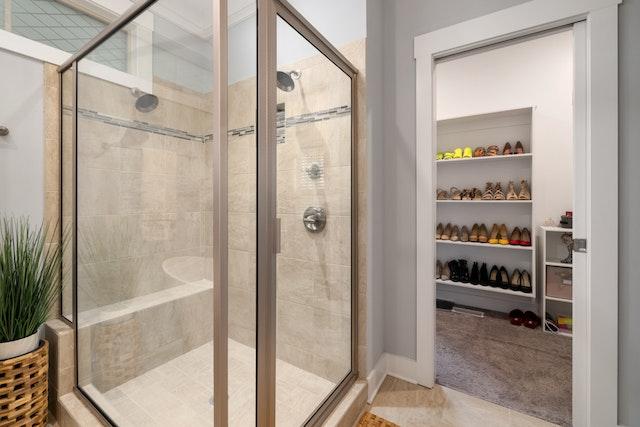
Section 20: Eco-Friendly Options for Your Home: Green Bathroom Remodeling
20.1 Energy-saving lighting
A bathroom can be made more environmentally friendly by using energy-efficient fixtures. Look for products with the Energy Star label, which are engineered to consume less power and water while still performing at a high level. Energy-efficient fixtures can help you use less energy, pay less for utilities, and be better for the environment.
20.2 Low-flow toilets and showerheads, version
Showerheads and toilets with low water usage are additional environmentally friendly bathroom options. While maintaining the same level of performance, these fixtures are made to use less water. You can contribute to water conservation and cut down on your water usage by installing low-flow fixtures.
20.3 Eco-Friendly Materials
Consider sustainable options when making your bathroom remodel material selections. Materials like bamboo, recycled glass, or recycled plastic may be included in this. Sustainable materials can be more long-lasting and simple to maintain while also helping to lessen the environmental impact of your bathroom remodel.
20.4 LED Lighting
Another environmentally friendly option for your bathroom is LED lighting. In addition to being more energy-efficient and lasting longer than conventional incandescent bulbs, LED bulbs come in a variety of colors and designs. You can reduce your energy use and carbon footprint by selecting LED lighting for your bathroom.
Section 21: Choosing a Contractor for Your Bathroom Remodel in
21.1 Examine and Compare Businesses
It’s crucial to shop around and compare different companies before choosing a contractor for your bathroom remodel. Look for remodeling experts who have experience with bathrooms, and make sure to read reviews and request references. To get a sense of the costs associated with your project, you might also want to request estimates from a number of contractors.
21.2 Verify Insurance and Licensing
It’s crucial to confirm that any contractor you hire possesses the necessary insurance and licensing. In the event that accidents or other problems occur while remodeling, this will help to protect you. Before hiring a contractor, be sure to request documentation of their insurance and license.
21.3 Obtain a written agreement
Get a written contract in place before you start remodeling your bathroom. This will make sure that everyone is communicating clearly and that there are no misunderstandings. The scope of the work, the supplies and fixtures to be used, and the terms of payment should all be specified in writing.
21.4 Clearly communicate with your contractor
For a bathroom remodel to be successful, communication must be effective. Make sure to communicate to your contractor your goals and any specific requirements you may have. Establishing a transparent line of communication and setting up regular check-ins will help you stay informed about the status of your project.
Section 22: Typical Obstacles to Bathroom Remodeling and Solutions
22.1 Financial Limitations
Maintaining a budget during bathroom remodeling is a common challenge. It’s crucial to carefully plan and prioritize your expenses when undertaking remodeling projects because they can easily become expensive. Setting a firm budget before you begin your project and adhering to it is one way to stay within your allocated spending limit. Additionally, you might want to think about saving some extra money in case of unforeseen expenses or delays.
22.2 Constrained Space
Small bathrooms can present challenges in terms of layout and space. Making the most of your available storage and selecting compact fixtures are two ways to get around this problem. For the purpose of giving the impression of more space, you might also want to think about using light colors and mirrors.
22.3 Different design preferences
Working with a partner or spouse may present difficulties due to differences in design preferences. Compromise and coming up with a solution that works for both of you are two ways to get past this obstacle. To find a design that satisfies both your needs and preferences, you might also want to think about hiring a designer.
22.4 Licenses and Rules
Bathroom remodeling projects can present difficulties with regard to obtaining permits and following building codes. Working with a contractor who is knowledgeable about the permitting procedure and can assist you in navigating any regulations or requirements is one way to get past this obstacle.
Section 23: Upkeep of Your Bathroom Following a Remodel
23.1 Consistent Cleaning
Cleaning your bathroom frequently is one way to maintain it after a remodel. This might entail cleaning the toilet and sink, sweeping and mopping the floor, and wiping down surfaces. Regular cleaning will keep dirt, grime, and bacteria from accumulating while also making your bathroom feel and look clean and inviting.
23.2 Protecting Fixtures and Surfaces from Damage
It’s critical to look after your fixtures and surfaces to help maintain your bathroom after a remodel. This might entail keeping heavy objects off of countertops, covering your sink with a cutting board, and avoiding using abrasive cleaners or scouring pads on your fixtures. You can make sure that your surfaces and fixtures last longer and keep their appearance by taking care of them.
23.3 Updating the caulk and grout
To keep the appearance of your bathroom, grout and caulk may need to be updated as they grow soiled or discolored over time. After remodeling, think about replacing any caulk or grout that is soiled or discolored to help maintain your bathroom. This can help prevent water damage and restore your bathroom’s sleek, polished appearance.
23.4 Fixing any blemishes or signs of wear and tear
Repairing any damage or wear and tear as it happens is an additional way to maintain your bathroom after a remodel. This might entail repairing broken fixtures, replacing cracked tiles, or fixing leaks. You can help stop further damage and keep your bathroom’s appearance and functionality by taking care of any problems as soon as they arise.
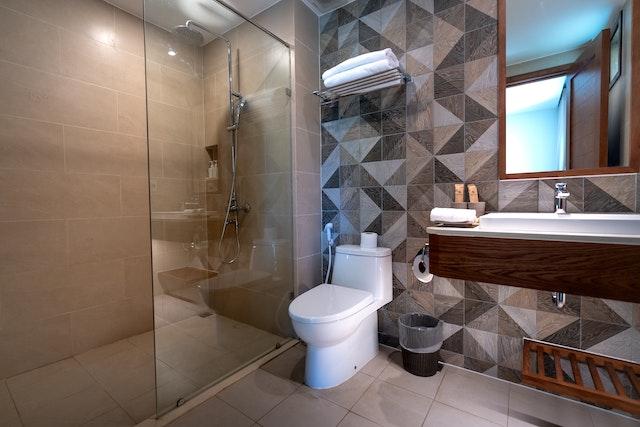
Section 24: Frequently Asked Questions About Bathroom Remodeling
24.1 How much does remodeling a bathroom cost?
Several variables, including the size of your bathroom, the fixtures and materials you select, and the extent of the remodel, can have a significant impact on the price of a bathroom remodel. A bathroom remodel typically costs between $10,000 and $20,000 in total. Your costs, however, could be significantly higher if you’re planning a more extensive remodel or if you’re using more expensive materials.
24.2 For how long does a bathroom remodel take?
The scope of the project and any unforeseen problems that might occur can affect how long it takes to remodel a bathroom. A bathroom remodel can typically be finished in a few weeks to a few months.
24.3. Can I renovate my bathroom myself?
Although it is possible, remodeling your bathroom yourself can be difficult and time-consuming. Depending on the scope of your remodel, you might need to hire experts for certain tasks, like electrical or plumbing work. It may be best to hire a contractor to handle your bathroom remodel if you don’t feel comfortable working on DIY projects or if you lack the necessary knowledge or equipment.
24.4 How can I make my tiny bathroom appear larger?
If your bathroom is small, you might be trying to figure out how to make it appear bigger and more open. Using light colors, adding mirrors, and selecting compact fixtures are some methods for making a small bathroom appear larger. To give the impression of more space, you might also want to think about using a glass shower door or a transparent shower curtain.
Section 25: Final Thoughts on Bathroom Remodeling
Bathroom remodeling can be a fulfilling and life-changing experience, but it’s crucial to plan and prepare thoroughly before beginning your project. You can design a bathroom that satisfies all of your requirements and exceeds your expectations by taking into account aspects such as budget, layout, materials, and fixtures. You can design a bathroom that is both practical and fashionable with careful planning and attention to detail.
To make sure that your bathroom remodeling project is a success, it’s crucial to work with a qualified and experienced contractor. A competent contractor will be able to assist you in navigating the challenges of bathroom remodeling and will be there to help you every step of the way.
In order to keep your bathroom looking and operating at its best after a remodel, maintenance is essential. You can help keep your bathroom in excellent condition by keeping it clean, avoiding damage to surfaces and fixtures, updating grout and caulk, and fixing any damage or wear and tear. You can take pleasure in your newly renovated bathroom for many years to come with careful maintenance and attention to detail.
Conclusion
In conclusion, remodeling a bathroom can be a difficult and complex process, but it can also be gratifying and life-changing. When planning a bathroom remodel, there are many things to take into account, from choosing materials and fixtures to maximizing storage and improving lighting. Working with a qualified and experienced contractor is crucial if you’re planning a bathroom remodel in New York City if you want to make sure that your project is successful.
With our knowledge and experience, New York City Bathroom Remodel can assist you in designing the bathroom of your dreams. We can help you with every step of the remodeling process, from planning and design to building and finishing. We have the knowledge and tools to support you in achieving your objectives, whether you’re looking to renovate a small bathroom or build a luxurious spa retreat. To find out more about how we can assist with your bathroom remodeling project in New York City, get in touch with us right away.

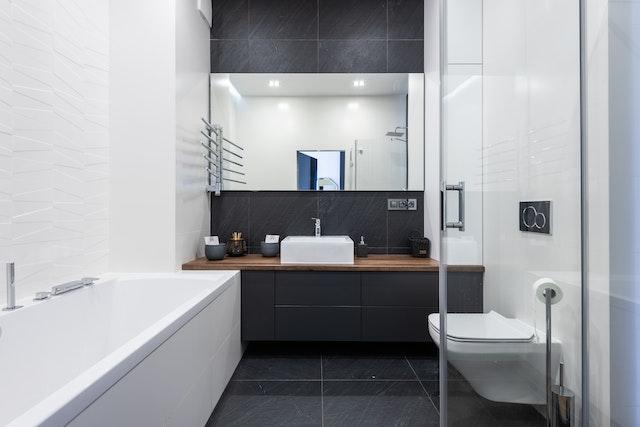
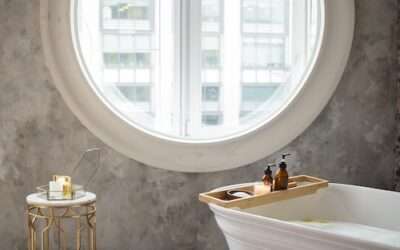
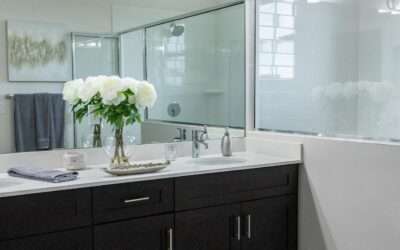
0 Comments